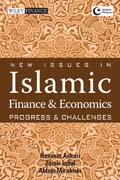
New issues in islamic finance and economics: progress and challenges
Askari, Hossein
INDICE: Chapter I: Development and Progress: This chapter provides the context and rationale for emergence of Islamic finance, motivation and other factors in the development of the demand for Islamic finance. A short summary of theoretical advancements in Islamic finance is provided, including the development of financial institutions in the private and the public sector. An assessment of achievements is made. Finally, the development of regulatory framework, standards setting organizations, and role of Islamic Development Bank (IsDB) in promoting Islamic finance is assessed. (30 pages) Chapter II: Issues and Challenges: This chapter sets the tone for the remaining chapters by providing a review of theoretical and practical issues facing the market and lists the challenges facing the industry. Challenges in the area of financial infrastructure, financial innovation, public finance, and governance are addressed. (30 pages) Chapter III: Developing a Theory of Islamic Economics Economic thoughts are the foundation of financial transactions and financial systems. This chapterexamines the progress made in the area of Islamic economics and the challenges it faces in providing theoretical foundation for a comprehensive financial system. Chapter IV: Development of Institutions: This chapter focuses on the concept of economic institutions in Islam. Notions of property rights, contracts, social justice and trust are addressed. Chapter IV provides a comparison of these institutions with similar concepts in a conventional economic system. (30 pages) Chapter V: Globalization: In this chapter the economic and financial sector implications of globalization for Muslim countries are analyzed. Muslimcountries will need to develop effective institutions in order to benefit from globalization. This chapter discusses the impact and opportunities for Islamic finance in this era of globalization. The chapter shows how globalization can benefit further growth of Islamic finance if proper institutions are developed. (30 pages) Chapter VI: Financial Infrastructure: This chapter discusses the existing financial infrastructure within which Islamic Financial Institutions (IFIs) operate and will identify the gaps in the infrastructure. The chapter highlights the areas where further development is required. Development of infrastructure to develop money and capital markets so that the full potential of Islamic finance is exploited is also discussed. Chapter VII: Governance Framework: This chapter builda upon the concept of institutions and will develop a framework of governance centered on a stakeholder-based concept. Issues pertaining to the governance of Shariah boards and optimal governance structure are discussed. (25 pages) Chapter VIII: Trust and Reputation Risk: This chapter makes an assessment of the reputation risk that Islamic financial institutionsare exposed to, the effect of negligence or misconduct, and how failure of one institution may lead to reputation of the industry. Chapter VIII also makes policy recommendations for mitigating such risk. (20 pages) Chapter IX: Micro-and Medium-Sized Institutions: It is often argued that Islamic finance is moreconducive to micro and medium-sized institutions (MMEs). This chapter furtherexplores this argument and examines the contribution which small and medium size institutions can make for further growth of Islamic finance and ultimatelyto economic development. (25 pages) Chapter X: Public Finance: This chapter discusses the challenge of providing effective financial instruments for publicsector financing. The chapter discusses the implication of shortage of such instruments for countries wishing to implement an economy-wide system accordingto Islamic principles. Some suggested instruments will also be put forward and analyzed. (25 pages) Chapter XI: Social Welfare Finance: This chapter discusses the scope of providing social welfare through Islamic finance. The concepts of Zakat, Qard-e-Hasna and Waqf are discussed and an assessment of their potential made. The idea of designing a safety net according to principles of Islamic finance is explored. (30 pages) Chapter XII: Islamic Finance and Development: A review of the ways by which Islamic finance can make a contribution to sustainable development is provided in this chapter. What are the ingredients of long-term growth and what are the solutions offered by Islam? (25 pages) Chapter XIII: Conclusion: This chapter provides a summary and a forward-looking analysis of the field of Islamic finance. (20 pages)
- ISBN: 978-0-470-82293-7
- Editorial: John Wiley & Sons
- Encuadernacion: Cartoné
- Páginas: 320
- Fecha Publicación: 30/09/2008
- Nº Volúmenes: 1
- Idioma: Inglés
